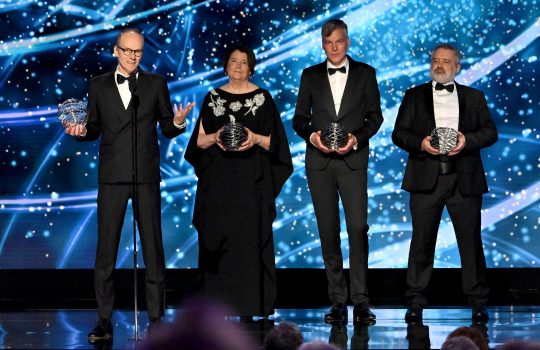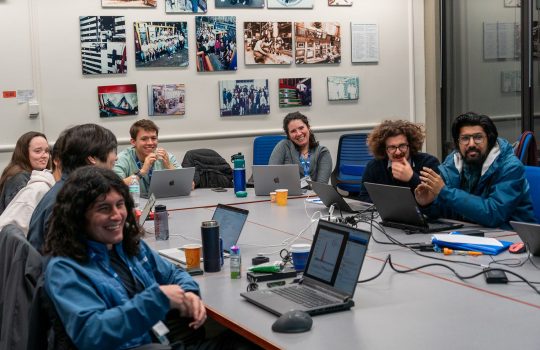Batavia, Ill. – Scientists of the US CMS collaboration joined colleagues around the world in announcing today (February 28) that the heaviest piece of the Compact Muon Solenoid particle detector has begun the momentous journey into its experimental cavern 100 meters underground. A huge gantry crane is slowly lowering the CMS detector’s preassembled central section into place in the Large Hadron Collider accelerator at CERN in Geneva, Switzerland. At 1,950 metric tons, the section, which contains the detector’s solenoid magnet, weighs as much as five jumbo jets and is 16 meters tall, 17 meters wide and 13 meters long. Its descent is expected to take about 10 hours.
“This is a challenging feat of engineering, as there are just 20 centimeters of leeway between the detector and the walls of the shaft,” said CERN physicist Austin Ball, technical coordinator of CMS. “The detector is suspended by four massive cables, each with 55 strands, and attached to a step-by-step hydraulic jacking system, with sophisticated monitoring and control to ensure the object does not sway or tilt.”
Of the CMS collaboration’s approximately 1500 physicists, about one-third are U.S. scientists. The Department of Energy’s Fermi National Accelerator Laboratory is the host laboratory for US CMS, and U.S. scientists have designed, built and delivered to CERN several key elements of the CMS detector. Currently, U.S. contributions to CMS are more than 98 percent complete. A U.S. team from Fermilab recently carried out a precision mapping of the magnetic field of the CMS solenoid magnet that is being lowered today. By observing the curvature of the paths of charged particles in the magnetic field, physicists will calculate the energy of particles flying out from billions upon billions of proton-proton collisions that will occur inside the detector.
“We are proud of our contribution to the extraordinary international scientific endeavor now taking shape at the LHC,” said Associate Director for High Energy Physics at DOE’s Office of Science Dr. Robin Staffin. “We applaud the engineering tour de force of today’s CMS milestone at CERN. Each step forward at the LHC experiments and the accelerator brings us closer to the start of scientific operations and to breakthroughs in our understanding of the physics of the universe.”
Experimenters have already lowered the first seven of 15 pieces of the CMS detector, with the first piece arriving in the experimental cavern on November 30, 2006. The giant section descending today marks the halfway point in the lowering process, with the last piece scheduled to make its descent in summer 2007. Particle detectors are typically assembled underground, where the accelerator tunnel is located. CMS has broken with tradition by starting assembly before completion of the underground cavern, taking advantage of a spacious surface assembly hall to preassemble and pretest the detector’s myriad components and systems.
“This is an impressive milestone in the complex installation of the CMS particle detector,” said Dr. Moishe Pripstein, Program Director at the National Science Foundation. “It augurs well for being ready for first beam collisions at the LHC. We are delighted that scientists from U.S. universities and from Fermilab are making substantial technical contributions to this grand international collaboration and look forward to exciting results in the next several years.”
Physicists are preparing the CMS detector and its sister detector, ATLAS, to take data at CERN’s Large Hadron Collider, where scientists predict that they will make fundamental discoveries about the universe, using very-high-energy proton collisions. Beyond revealing a new world of unknown particles, the LHC experiments could explain why those particles exist and behave as they do. They could discover the origins of mass, shed light on dark matter, uncover hidden symmetries of the universe, and possibly find extra dimensions of space.
-30-
Notes for editors:
Photos and graphics are available at http://photo.cern.ch/testusers/index.php?dir=CMS%2028%2002%2007
A live Webcam transmission of the event is at http://cmsinfo.cern.ch/outreach/cmseye/cam8.html
For 7-8 minutes of video, send FTP server address and login information to Jacques.Fichet@cern.ch
The United States contributions to the CMS experiment and the Large Hadron Collider are funded by the Department of Energy’s Office of Science and the National Science Foundation.
CERN is the European Organization for Nuclear Research, with headquarters in Geneva, Switzerland. At present, its Member States are Austria, Belgium, Bulgaria, the Czech Republic, Denmark, Finland, France, Germany, Greece, Hungary, Italy, Netherlands, Norway, Poland, Portugal, Slovakia, Spain, Sweden, Switzerland and the United Kingdom. India, Israel, Japan, the Russian Federation, the United States of America, Turkey, the European Commission and UNESCO have Observer status.
Fermi National Accelerator Laboratory is the host laboratory for the US CMS Collaboration. Fermilab is a Department of Energy National Laboratory operated under a contract with DOE by the Fermi Research Alliance.
US CMS member institutions
(49 institutions, from 22 states and Puerto Rico)
California
California Institute of Technology, Pasadena
Lawrence Livermore National Laboratory, Livermore
University of California, Davis
University of California, Los Angeles
University of California, Riverside
University of California, San Diego
University of California, Santa Barbara
Colorado
University of Colorado, Boulder
Connecticut
Fairfield University, Fairfield
Yale University, New Haven
Florida
Florida Institute of Technology, Melbourne
Florida International University, Miami
Florida State University, Tallahassee
University of Florida, Gainesville
Illinois
Fermi National Accelerator Laboratory, Batavia
Northwestern University, Evanston
University of Illinois at Chicago
Indiana
Purdue University, West Lafayette
Purdue University Calumet, Hammond
University of Notre Dame, Notre Dame
Iowa
Iowa State University, Ames
University of Iowa, Iowa City
Kansas
Kansas State University, Manhattan
University of Kansas, Lawrence
Maryland
Johns Hopkins University, Baltimore
University of Maryland, College Park
Massachusetts
Boston University, Boston
Massachusetts Institute of Technology, Cambridge
Northeastern University, Boston
Minnesota
University of Minnesota, Minneapolis
Mississippi
University of Mississippi, Oxford
Nebraska
University of Nebraska, Lincoln
New Jersey
Princeton University, Princeton
Rutgers State University of New Jersey, Piscataway
New York
Cornell University, Ithaca
Rockefeller University, New York
State University of New York at Buffalo
University of Rochester, Rochester
Ohio
Ohio State University, Columbus
Pennsylvania
Carnegie Mellon University, Pittsburgh
Puerto Rico
University of Puerto Rico, Mayaguez
Rhode Island
Brown University, Providence
Tennessee
University of Tennessee, Knoxville
Vanderbilt University, Nashville
Texas
Rice University, Houston
Texas A&M University, College Station
Texas Tech University, Lubbock
Virginia
University of Virginia, Charlottesville
Virginia Polytechnic Institute and State University, Blacksburg
Wisconsin
University of Wisconsin, Madison



